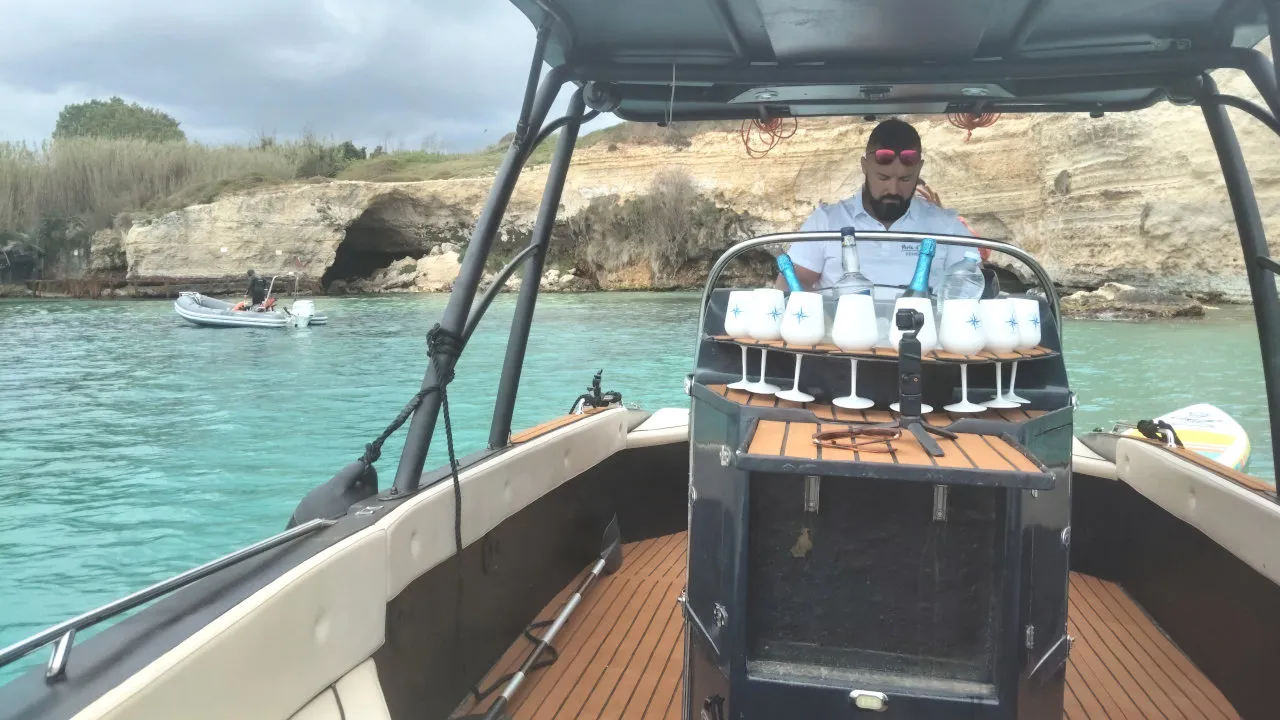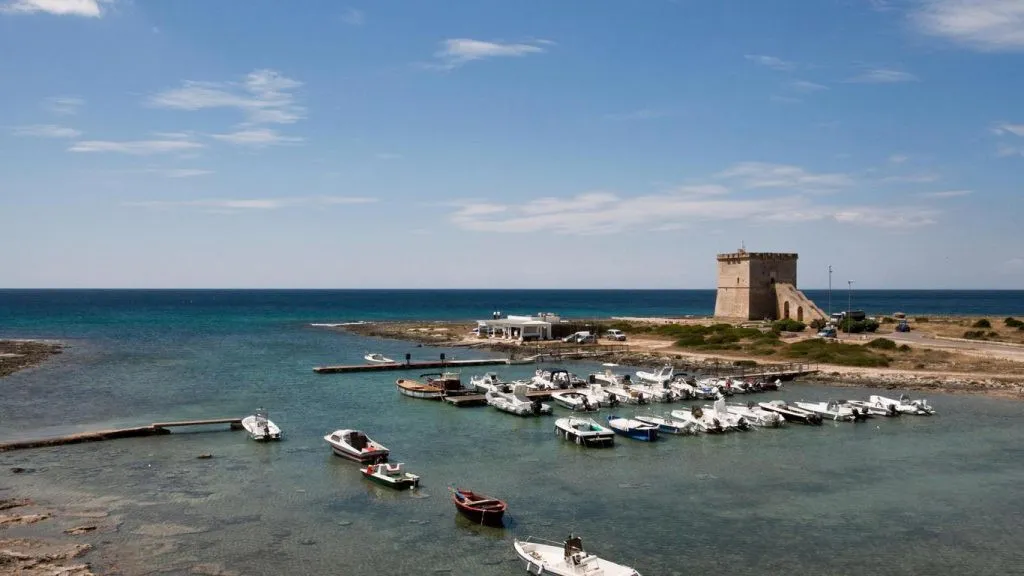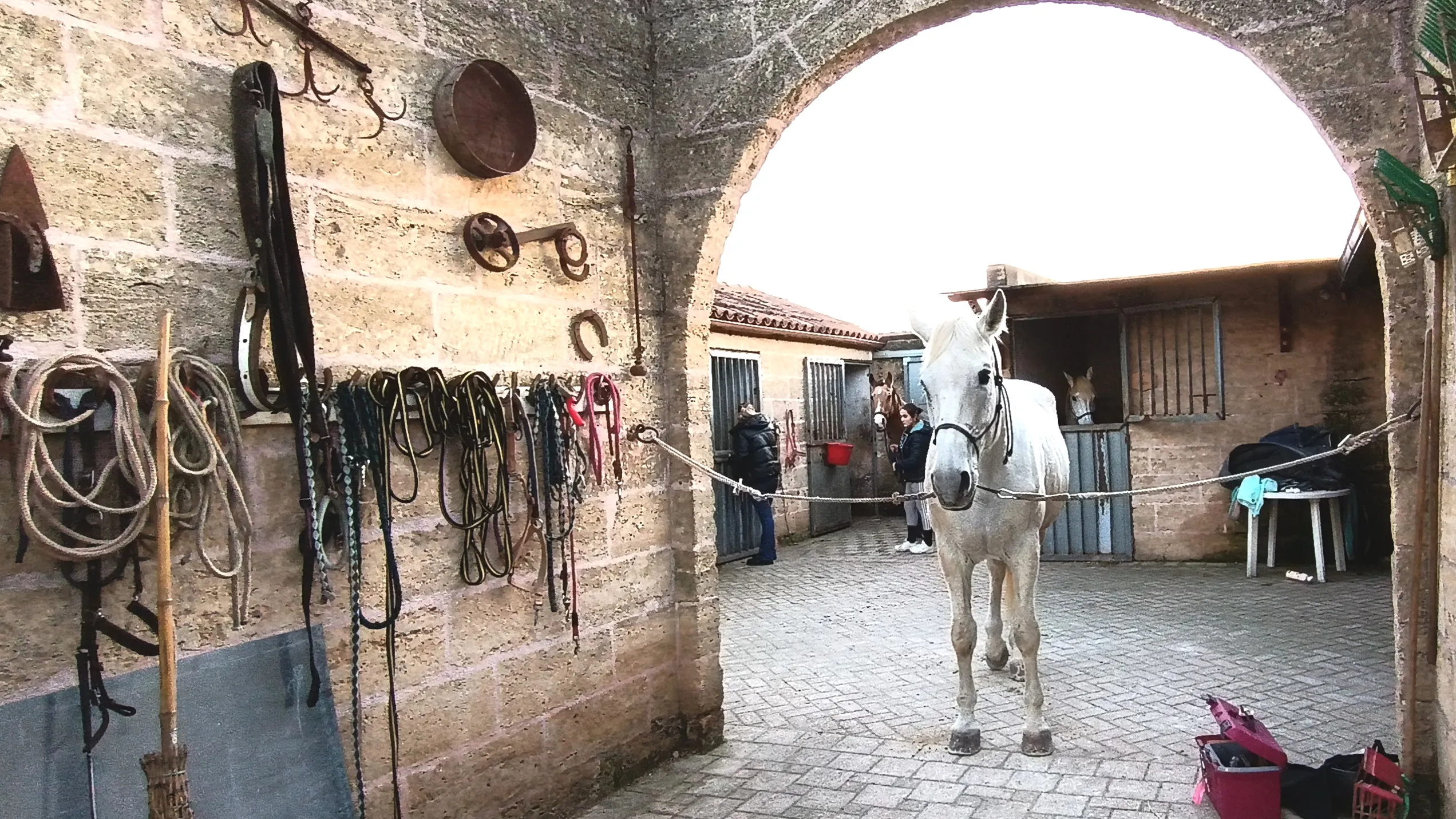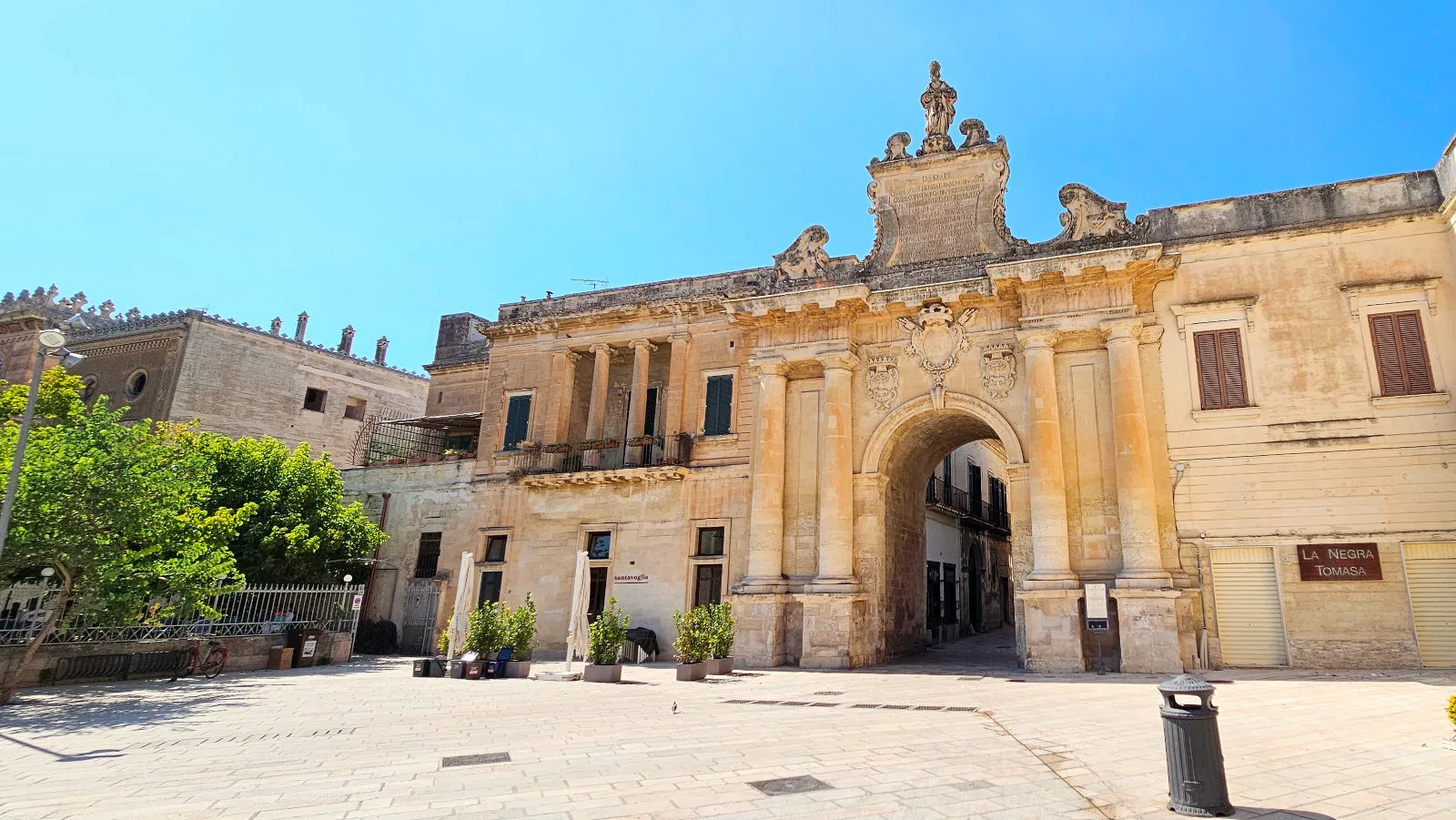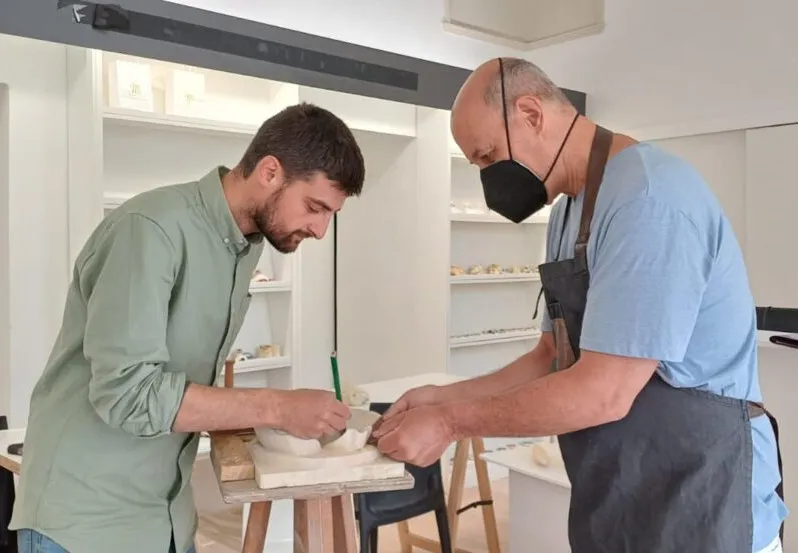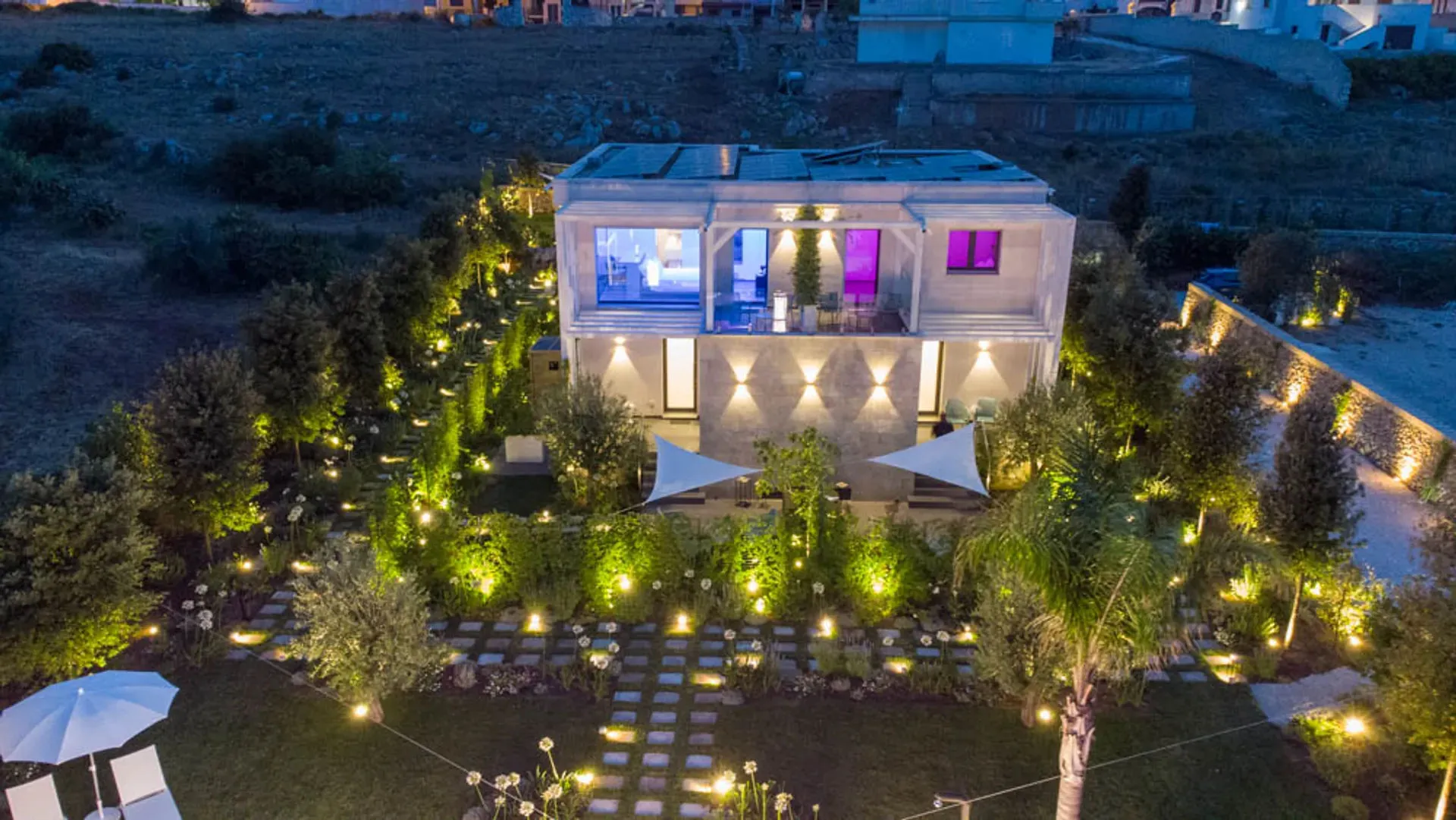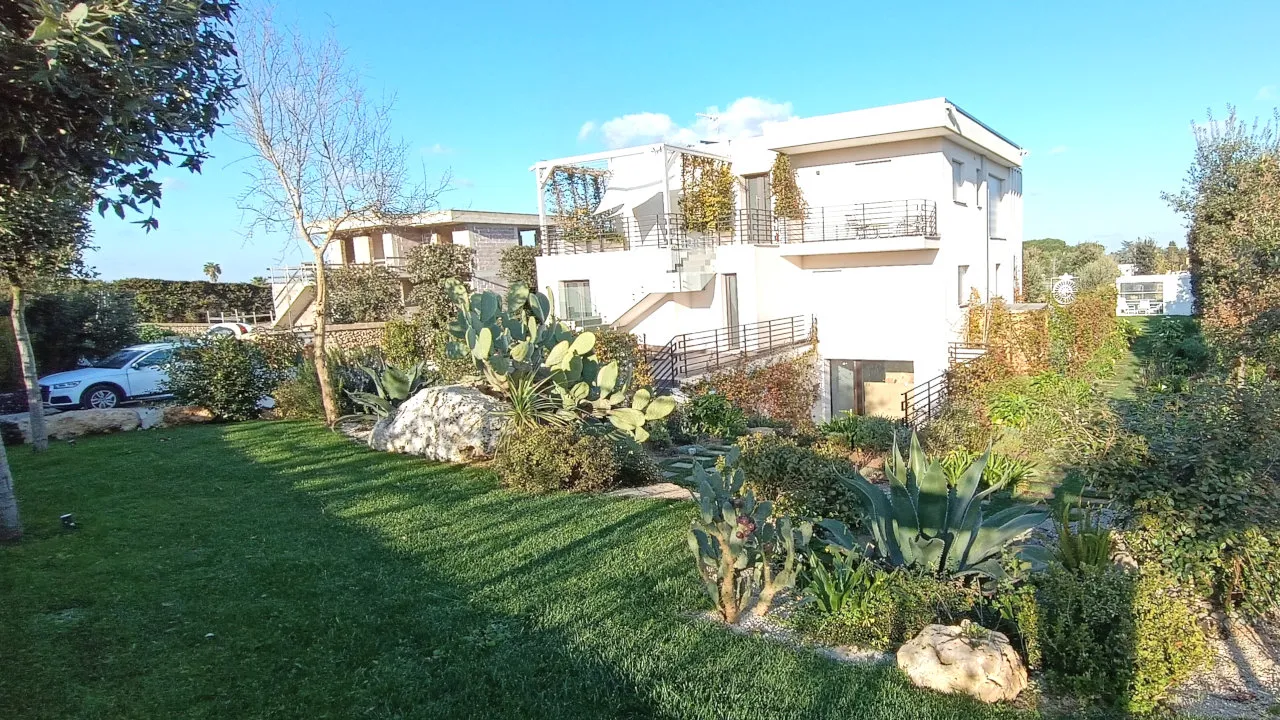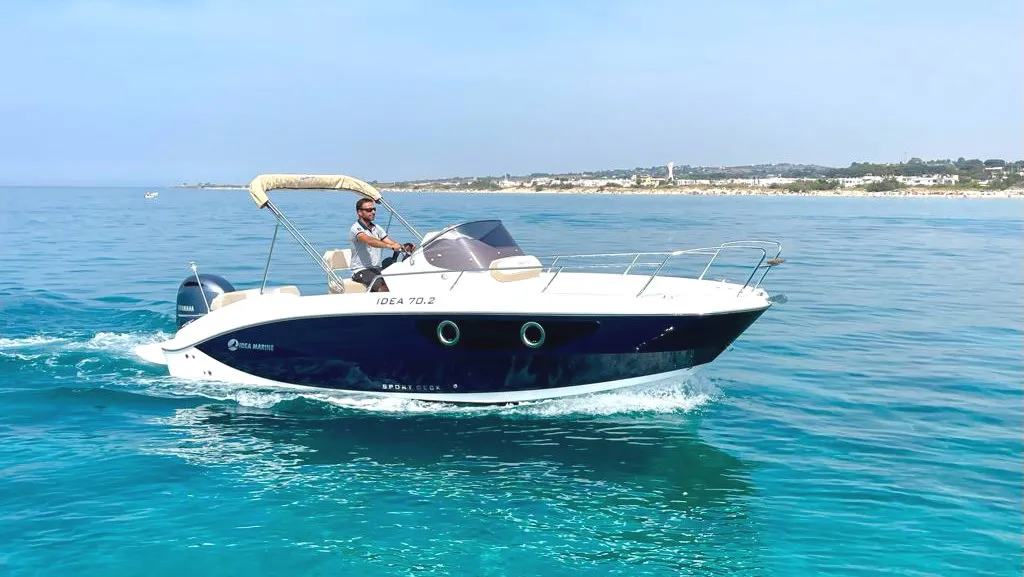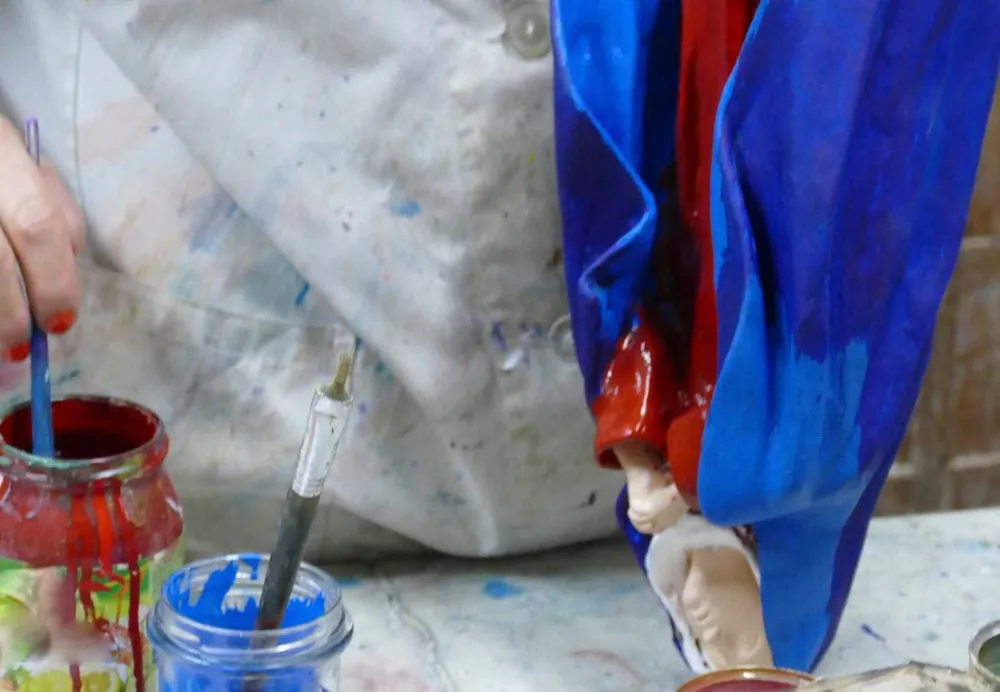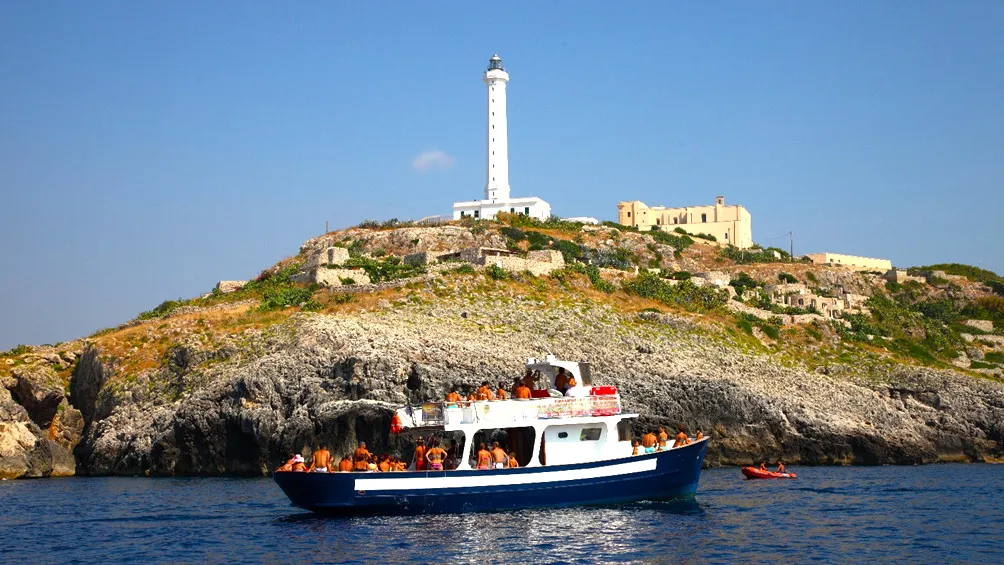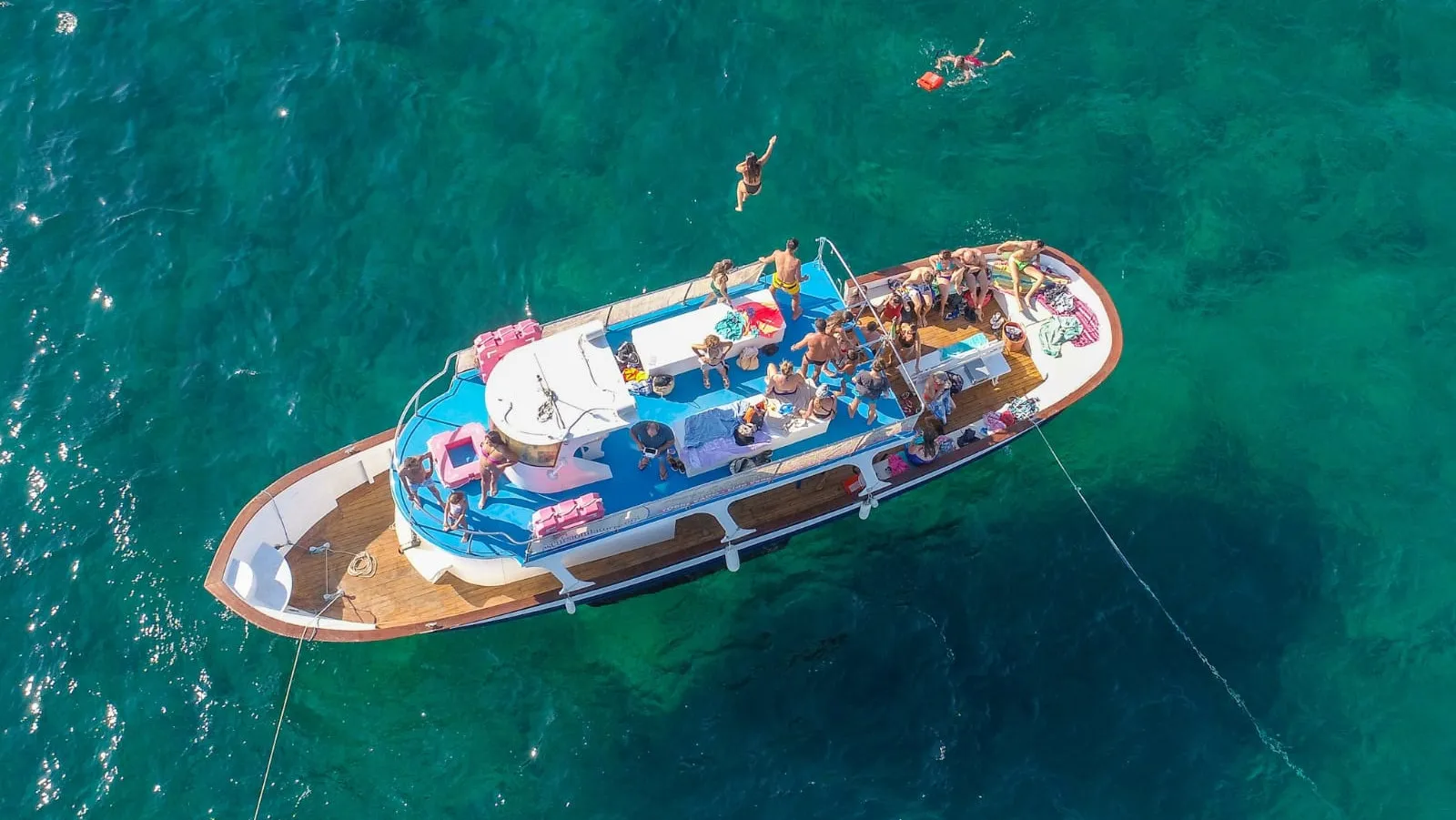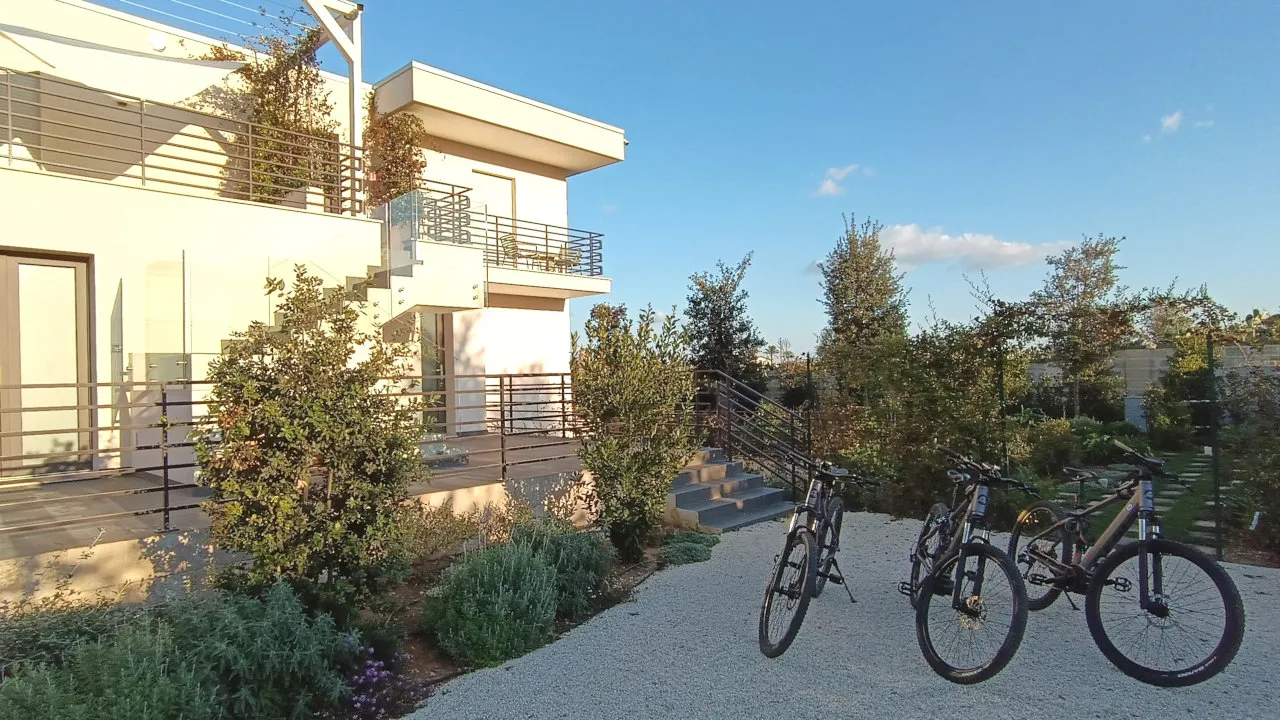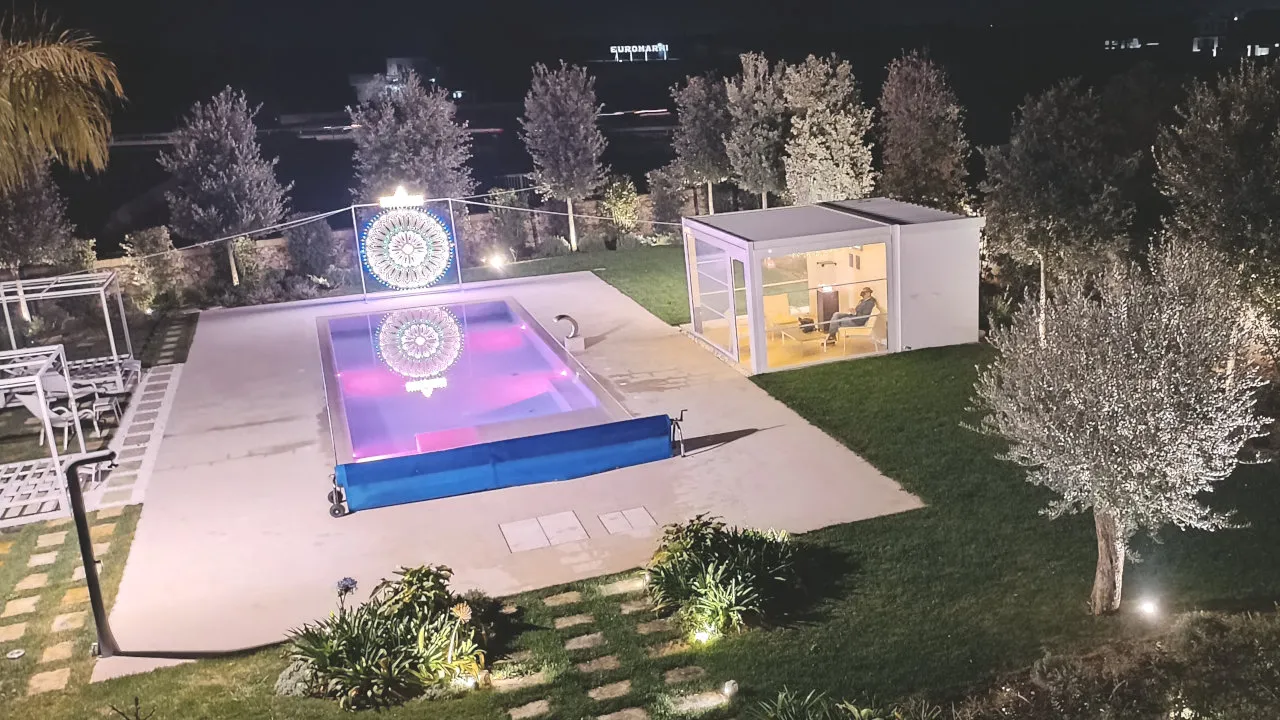Otranto: what to do and see, beaches, nature, history
Updated at: 25-01-2025
How this content can help you:
- You will discover the lively atmosphere of Otranto, among typical restaurants and local crafts.
- You will get to know the historic center with its alleys and historical monuments.
- You will learn about the history of the Port and the defensive Coastal Towers.
- You will explore the most beautiful beaches: Baia dei Turchi, Alimini, Torre Sant'Andrea, and others.
- You will visit nearby places like the Hypogeum of Torre Pinta and the Cave of the Deer.
- You will discover churches and monasteries rich in art and history.
- You will get to know the typical farmhouses and local gastronomy.
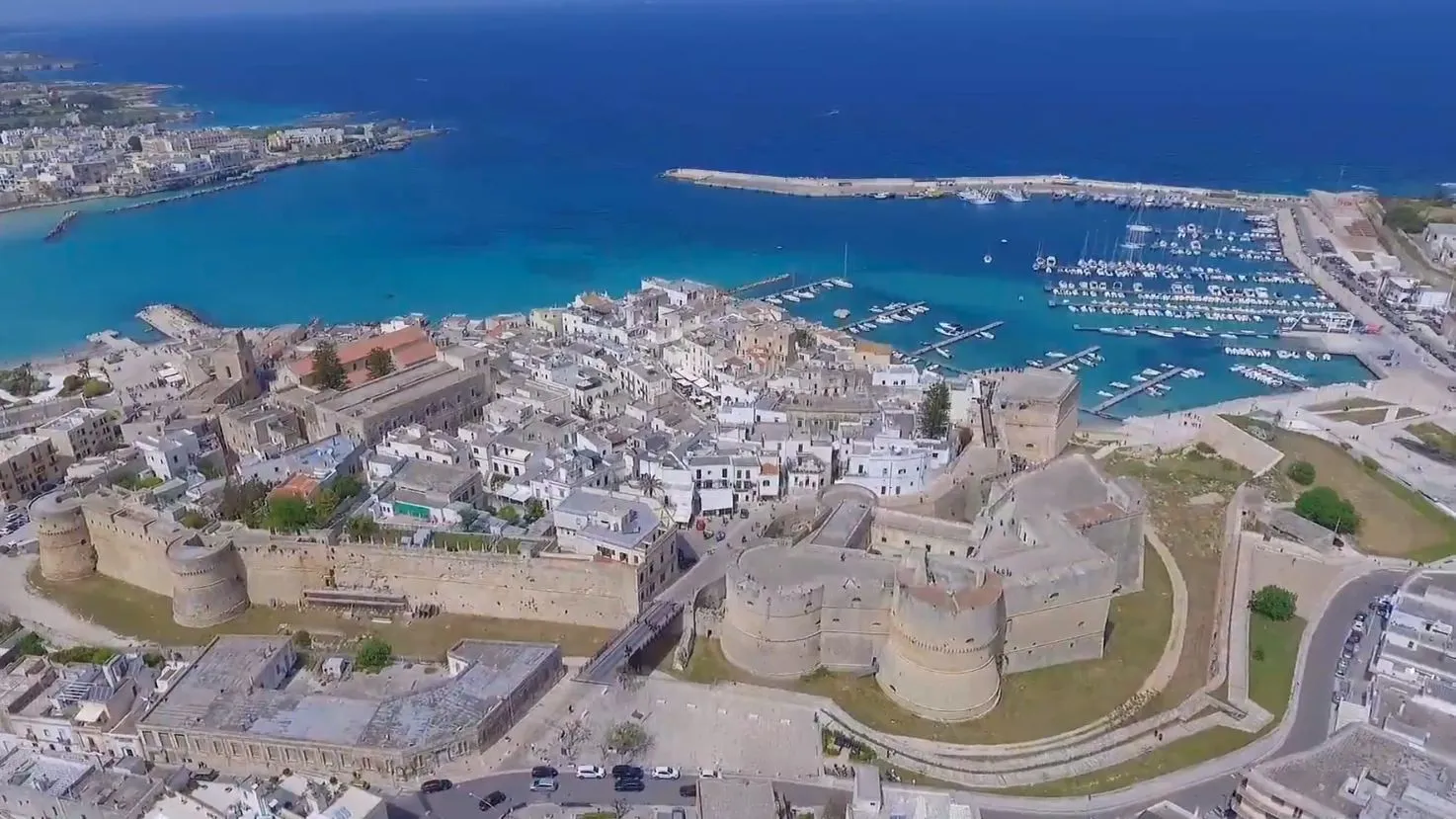
Why is Otranto famous?
Otranto, a charming coastal city in Puglia, is famous for its rich historical and cultural heritage, as well as its wonderful beaches. The city is home to the Cathedral of Otranto, famous for its medieval floor mosaic, and the majestic Aragonese Castle. The beaches of Otranto offer crystal clear waters, golden sand and hidden coves that enchant visitors. The vibrant historic center and lively cultural life make Otranto an unmissable destination.
How is the sea in Otranto?
The sea of Otranto is renowned for its clarity and intense colours. The coast extends for approximately 25 km, offering a variety of seascapes. To the north, you'll find sandy beaches ideal for families, while to the south, the coast becomes rockier, with sheer cliffs and hidden coves perfect for snorkelling and underwater exploration.
Otranto is a beautiful coastal town in the Salento region of Puglia, known for its rich history and natural beauty. It is the easternmost municipality in Italy – at Punta Palascìa the sunrise is first – and is known as the “city of the Martyrs” for the tragic events of 1480. Its historic center, enclosed by ancient walls, is part of the Borghi più belli d’Italia club and was recognized by UNESCO in 2010 as a Site of Peace. Otranto enchants visitors with a unique mix of beaches, ancient monuments (such as the Cathedral of the Martyrs with its famous mosaic), and a lively yet authentic atmosphere.
Otranto, with its 5,770 inhabitants, is located in the province of Lecce and overlooks the Adriatic Sea not far from Albania and Greece. Its origins date back to the Neolithic, but the modern city was founded by the Messapians, developing under Roman, Byzantine, and Aragonese rule, until becoming the historic jewel it is today.
In this guide we will discover what to see in Otranto, what to do in Otranto during your stay, the must-visit beaches, and many practical tips to make the most of your holiday in Otranto.
Things to see in Otranto
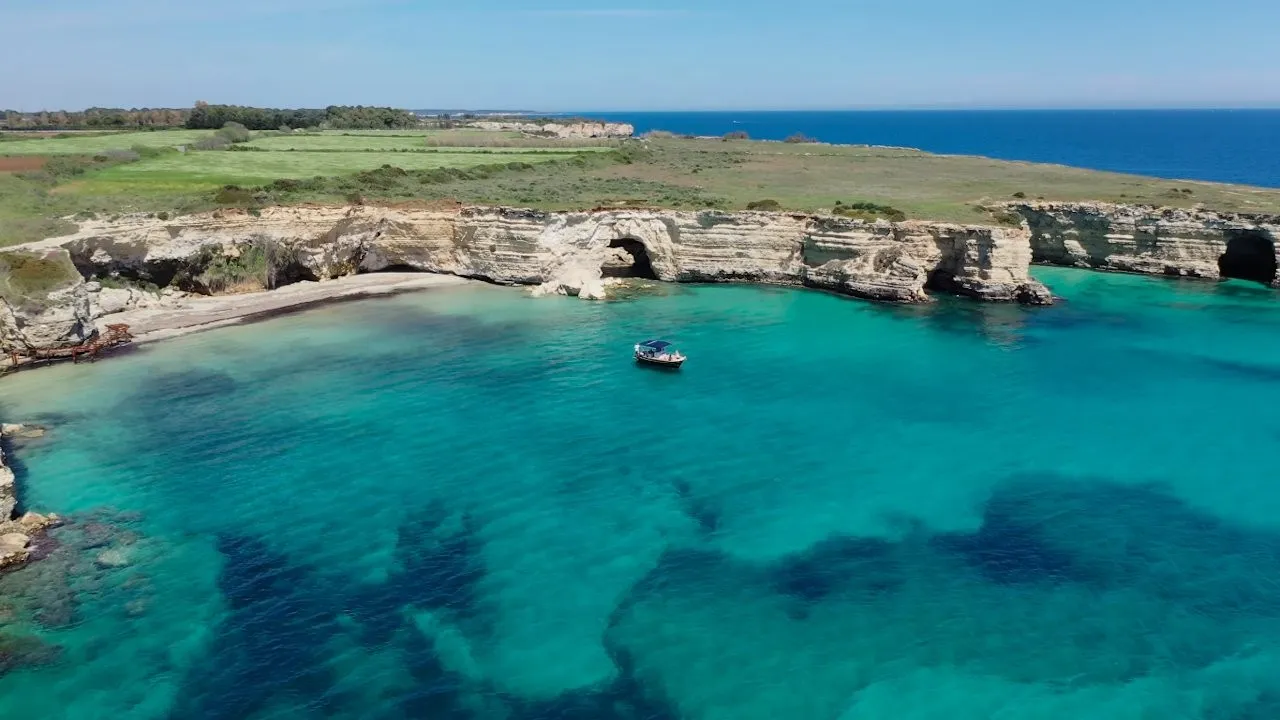
If you enjoy visiting historical and natural sites, Otranto offers a wide range of attractions to explore. Here are some of the best things to see in this charming city in Salento area.
Among the things we recommend seeing if you are visiting Otranto are:
- Aragonese castle
- Otranto Cathedral
- Alfonsina Tower and Aragonese Walls
- Lopez Palace
- Palazzo de Mori
- Churches
- Monasteries
- Rock crypts and churches
- Catacombs
Aragonese Castle
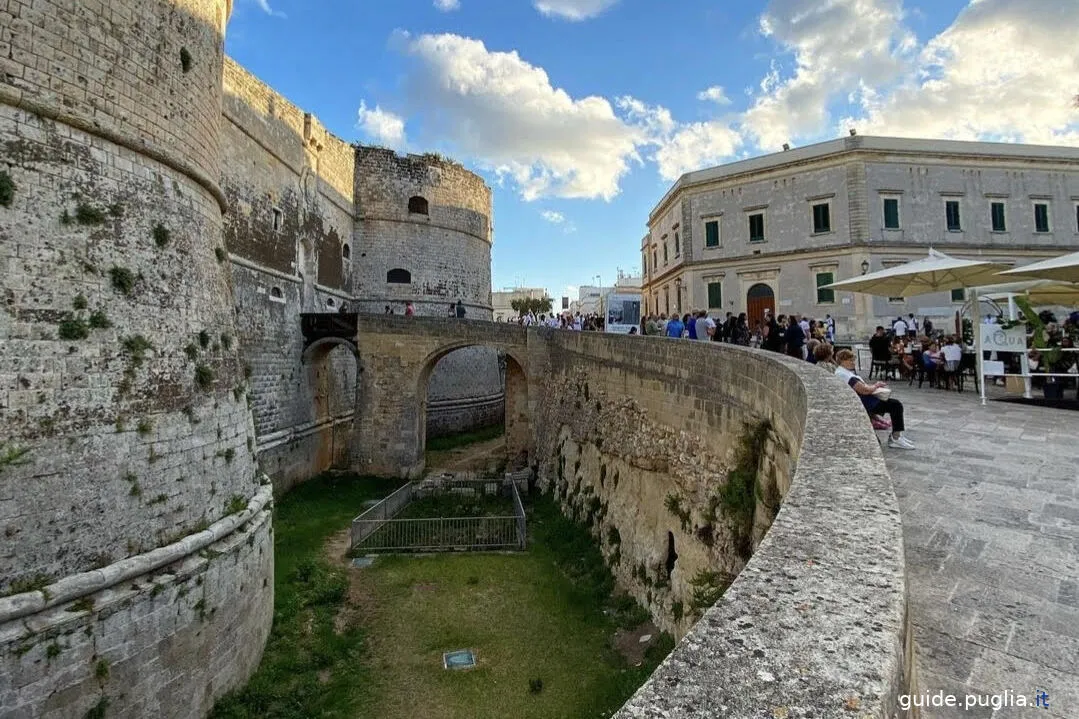
The Aragonese Castle in Otranto is one of the city's main attractions, symbolizing its history and military architecture. Here is a guide on what to see and some historical information.
The Aragonese Castle, also known as the "Forte a Mare", was built at the behest of Alfonso of Aragon starting from 1485, after the destruction of the previous structures following the Turkish invasion of 1480. Its purpose was precisely to stem the threat of enemy raids and raids by sea, such as those of the fearsome Ottomans.
The architects Ciro Ciri and Francesco di Giorgio Martini, experts in military architecture, were in charge of its construction. The fortress probably stands on a previous construction promoted by Frederick II of Swabia in 1228. The current appearance of the castle, with its pentagonal plan and deep moat, is the result of the modifications made by the Spanish viceroys.
The castle stands imposingly in front of the port and is directly connected to the entire city wall, which must be crossed to enter the center both by sea and by land, with which it forms the ancient defenses of the city of Otranto from incursions by sea.
At the Aragonese Castle in Otranto you can visit:
- The towers
- Moat and Drawbridge
- Internal Rooms and Exhibitions
- Courtyard and Stone Stairs
- Events and Exhibitions
The Towers
The castle features three circular towers made of carparo stone, named Alfonsina, Ippolita, and Duchessa, and a fourth tower extending towards the sea. The towers offer breathtaking panoramic views of the city and the sea, especially at sunset.
Moat and Drawbridge
The moat, originally filled with water and now transformed into a lawn, surrounds the castle. The drawbridge once allowed access to the fortress, protecting it from enemy attacks.
Interior Rooms and Exhibitions
Inside the castle are various rooms, including the striking Triangular Room with herringbone decorations. The castle also hosts temporary and permanent exhibitions, such as art displays and cultural events. For example, you can see exhibitions on local history and the Grotta dei Cervi.
Courtyard and Stone Stairs
Crossing the inner courtyard, a stone staircase leads to a balcony from which you can admire the castle’s internal architecture and enjoy a panoramic view.
Events and Exhibitions
Inside the Aragonese Castle of Otranto there are some permanent exhibitions. One of the main ones is dedicated to the history of Otranto and the castle itself, located on the ground floor. This exhibition explores the historical events of the castle and the city, including the cultural and architectural contributions of various eras.
Furthermore, on the top floor, it is possible to visit the exhibition "Places of Prehistory. Porto Badisco and the Grotta dei Cervi", which presents archaeological finds and information on the prehistory of the region.
Otranto Cathedral

The Otranto Norman Cathedral, dedicated to Santa Maria Annunziata, is one of the city's most significant monuments and a must-see for anyone visiting Salento.
The cathedral was built on the remains of previous constructions and consecrated in 1088. Over the centuries, it has undergone various refurbishments and restorations, especially after the Turkish siege of 1480, during which many original frescoes were destroyed and the structure itself was damaged.
A visit to the Cathedral of the Annunziata in Otranto is absolutely not to be missed for its Norman-era construction and for being able to admire its famous medieval mosaic art.
What to see in the Cathedral of Otranto:
- The Rose Window
- The Floor Mosaic
- The Martyrs' Chapel
- The Crypt
The Rose Window
The rose window of the Cathedral is a work of great artistic and technical beauty, made with polychrome marble and hard stones. It has a diameter of about 8.60 meters and features detailed depictions of animals, plants, and human figures. It is considered one of the largest rose windows in Italy and offers a breathtaking view when the sunlight filters through the colored glass.
The Mosaic Floor
Created between 1163 and 1165 by the monk Pantaleone, the mosaic floor of the cathedral covers the entire floor of the three naves. It consists of about 800,000 colored tiles and depicts a cycle of stories from the Old and New Testaments, including Adam and Eve, Noah's Ark, and the Tower of Babel. The mosaic covers almost the entire floor surface of the basilica, depicting a large tree with its base at the entrance of the church and the development of the trunk and branches towards the presbytery. This mosaic is a masterpiece of medieval art and has been included in the UNESCO World Heritage list.
The Chapel of the Martyrs
Located at the end of the right nave, this chapel houses the remains of the Holy Martyrs of Otranto, massacred by the Turks in 1480. The chapel was erected in 1481 and features frescoes depicting scenes from the lives of the saints and martyrs. The remains are kept in a gilded silver urn, and the “stone of martyrdom,” where the decapitation took place, is still visible.
The Crypt
Under the main altar lies the crypt, which preserves Byzantine frescoes from the 9th century, a white marble altar, and a Baroque baldachin. The crypt is a suggestive place and represents an important historical and artistic testimony.
Alfonsina Tower and Aragonese Walls
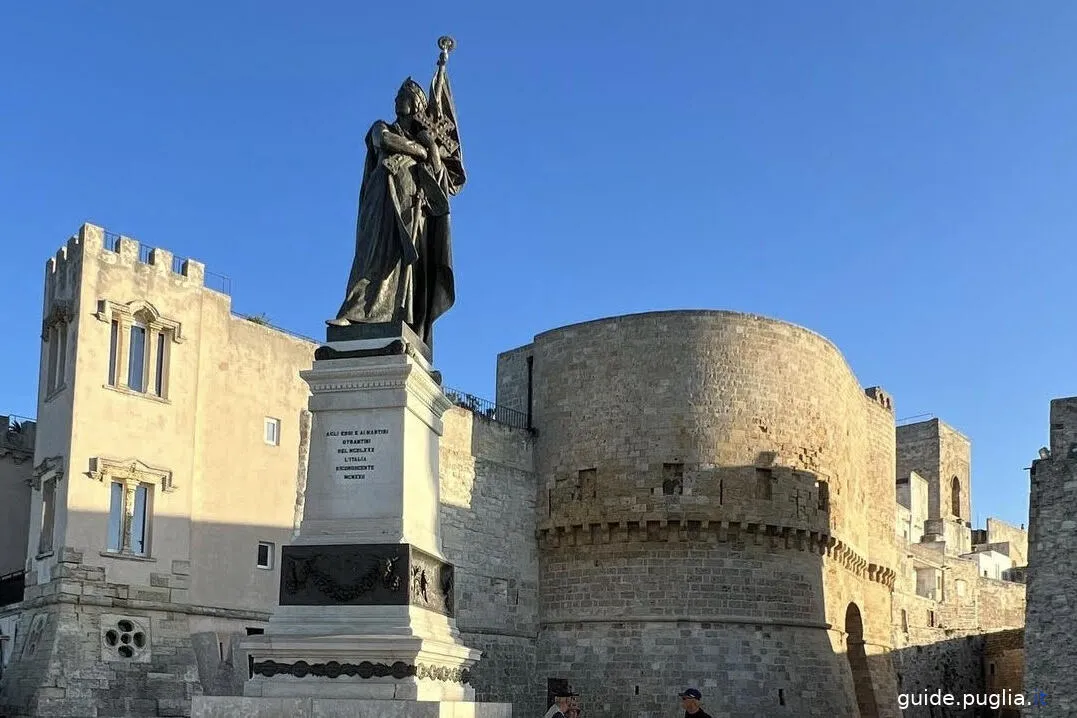
Otranto, one of the most fascinating cities in Salento, offers a rich history and numerous points of interest. Among these, the Torre Alfonsina and its walls are a must-see. Here is a guide on what to see and some historical information.
The Torre Alfonsina, also known as Porta Alfonsina, was built in the 15th century during the Aragonese rule. It is named after Alfonso I of Aragon, who contributed to the liberation of the city from the Turkish invasion in 1480. This tower was part of the city's defensive system, designed to protect it from attacks by sea.
What to see at the Alfonsina Tower and on the Walls in Otranto:
- Aragonese walls
- Porta Alfonsina
- Aragonese castle
Aragonese Walls
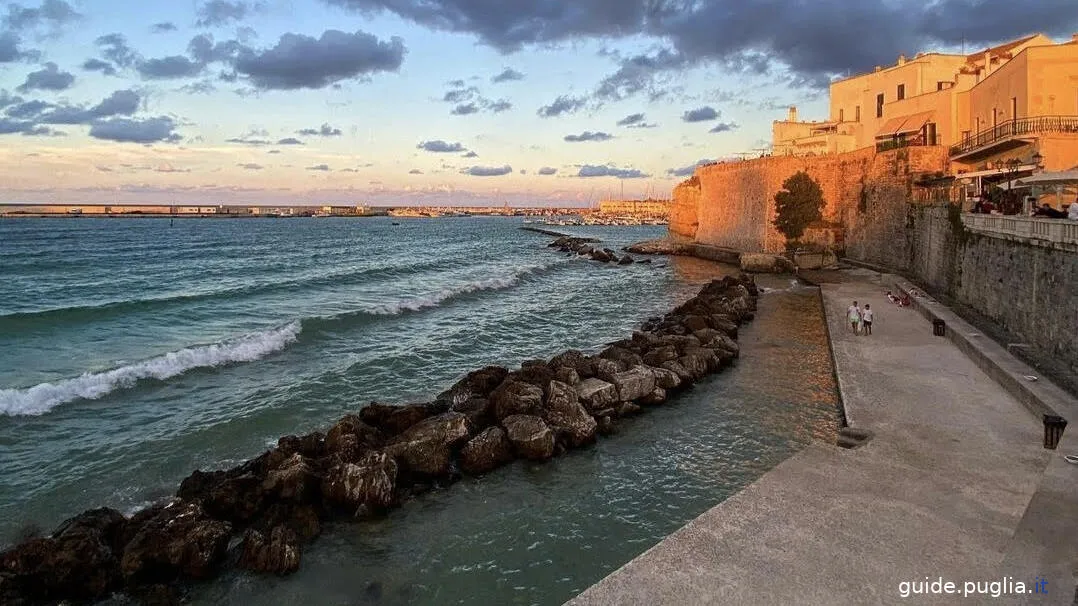
The walls surrounding Otranto are an exceptional example of Aragonese military architecture. Walking along the bastions, you can enjoy a panoramic view of the city and the Adriatic Sea. The best time to enjoy this walk is at sunset when the colors of the sky reflect on the sea, creating a breathtaking spectacle.
Porta Alfonsina
This is the main gate of the city, dedicated to Alfonso II of Naples. Passing through it, you enter the heart of Otranto's historic center, a labyrinth of picturesque cobbled streets. Porta Alfonsina is well preserved and represents one of the most evocative entrances to the old city.
The Aragonese Castle
Located near Torre Alfonsina, the Aragonese Castle is another important point of interest. Built at the end of the 1400s, the castle played a crucial role in the city's defense. Today, it hosts exhibitions and cultural events, and it is possible to visit its towers for a spectacular view of Otranto and the sea.
Palazzo Lopez
Palazzo Lopez is one of the most fascinating historical buildings in Otranto, built by the noble Lopez family during the Spanish rule. This palace represents a significant example of noble architecture from the era and offers visitors a glimpse into the city’s history and culture. Here’s what to see and some relevant historical information.
Palazzo Lopez was built in the 17th century and constitutes an important example of civil architecture from the period. The oldest part of the palace is the house-tower, a typical defensive structure of the time. Later, it was expanded with the construction of the adjacent noble residence. Since 1992, the palace has housed the Diocesan Museum, which exhibits numerous religious artifacts and works of art.
Things to see at Palazzo Lopez in Otranto:
- Tower House
- Noble Residence
- Diocesan Museum
Tower House
The oldest part of the palace, dating back to the 17th century, is a defensive structure that represents the original core of the building. The tower offers a unique insight into the military and architectural history of Otranto.
Noble Residence
Adjacent to the tower house, the noble residence was added later and represents an example of noble architecture with decorated interiors and an elegant courtyard. The frescoes and period furnishings are particularly evocative.
Diocesan Museum
The palace houses the Diocesan Museum, which displays a rich collection of sacred art, manuscripts, relics, and liturgical vestments from the Diocese of Otranto. This museum is an ideal place to deepen your knowledge of the religious and cultural history of the region.
Palazzo de Mori
Palazzo de Mori is one of the most charming historical residences in Otranto, located on the bastions of the historic center. Built in the 15th century, the palace belonged to the noble Michele Leondari, one of the 800 martyrs of Otranto who defended the city from the Saracen invasion.
The palace has been fully renovated, maintaining its authentic character as a historical residence with a stone-paved patio, tile roofs, and stone columns defining the terrace parapet.
Among the things to see at Palazzo de Mori in Otranto there are:
- Panoramic Terrace
- Sea View Breakfast
- Rooms and Suites
Panoramic Terrace
One of the main attractions of the palace is the panoramic terrace that offers an enchanting view of the bay of Otranto. Guests can enjoy breakfast here while taking in the splendid sea view, making for a truly relaxing and picturesque experience.
Sea View Breakfast
Guests can savor a light and genuine breakfast made with local products, served on the terrace with a sea view. The staff at the palace is always available to suggest the best restaurants for lunch and dinner nearby.
Rooms and Suites
Palazzo de Mori offers various types of rooms, from Classic rooms with double beds and views of the castle to Superior rooms with sea views, and Suites with a canopy double bed and a second small double bed. Each room is tastefully furnished and equipped with modern comforts.
Churches in Otranto
Otranto, a city rich in history and culture, boasts numerous churches of great historical and artistic interest. Here’s a guide on what to see to immerse yourself in the spirituality and history of this fascinating Salento location.
Church of Santa Maria dei Martiri
The Church of Santa Maria dei Martiri was built in 1614 in memory of the massacre of the 800 Christian martyrs by the Turks in 1480. This church is located on a hill overlooking the city and offers a breathtaking panoramic view. Adjacent to the church is a convent of the Order of Saint Francis of Paola.
Church of Madonna dell'Altomare
The Church of Madonna dell'Altomare, built in the 17th century on a tufa spur descending directly into the sea, is dedicated to the Holy Spirit. The church is rich in maritime decorations that reflect the city's connection to the sea. It is a perfect place for those seeking a moment of peace and reflection with a spectacular view.
Church of Madonna del Passo
This church, dating back to the 16th century, was built to commemorate the passage of the inhabitants of Otranto in 1480 before being massacred by the Turks. It is a place of great historical and religious significance, recalling one of the city's most tragic moments.
Crypt of the Holy Trinity
The Crypt of the Holy Trinity, dating back to the 10th-11th century, is located near the Colle della Minerva. This evocative place is an extraordinary example of underground religious architecture, offering an atmosphere of mystery and sacredness. The tomb of actor Carmelo Bene is also located here, providing additional interest for visitors.
Monasteries in Otranto
Otranto is not only famous for its beaches and historic center but also for its monasteries that tell stories of faith, art, and culture. Here’s a guide on what to see and some historical information about the main monasteries in the area.
Monastery of San Nicola di Casole
The Monastery of San Nicola di Casole is one of the most important cultural centers of the Middle Ages in Salento. Founded in 1098 by Basilian monks, the monastery housed one of the richest libraries in Europe, with manuscripts in Greek and Latin. Although only ruins remain today, visiting this site offers an impressive testimony to the religious and cultural history of Otranto.
Sanctuary of Santa Maria dei Martiri
The Sanctuary of Santa Maria dei Martiri is located on the Colle della Minerva, the highest point in Otranto. This place is significant for the massacre of the 800 martyrs of Otranto, which occurred in 1480. Built in 1641, the sanctuary is a place of pilgrimage and reflection on faith and sacrifice.
Monastery of San Giovanni
Located on the hill of the same name, the Monastery of San Giovanni is a hypogeal complex that originally belonged to the Jewish or early Christian community and was later used as a necropolis. This archaeological site offers a unique perspective on ancient funerary practices and religious life of the era.
Church and Convent of Santa Maria del Passo
The Church and Convent of Santa Maria del Passo, dating back to the 16th century, commemorates the passage of the inhabitants of Otranto before the massacre of 1480. This historical site is a landmark for understanding the tragic events that marked the city and its community.
Otranto Historic Center

The jewel of the area is the city of Otranto itself with its impeccable seafront with built-in beach and the remarkable historic center overlooking the sea.
Visiting the historic center of Otranto is absolutely one of the main things to do if you are on holiday in Puglia and will allow you to get to know the culture of the Salento area in depth. The ancient walls of the center develop around the imposing Aragonese Castle and the Norman Cathedral of the Annunziata, located right in front of the port in the city centre.
The main feature that strikes every tourist visiting Otranto is the cluster of historic buildings, intersected by alleys and streets, all gathered within the walls of the Castle.
The renowned natural beauty of Otranto and its sea causes the inhabitants to multiply during the summer period, giving visitors real pleasure in spending their holidays there.
This jewel of Salento is a bridge between West and East, as demonstrated by the architecture of the numerous historic buildings and places of worship in the centre, including the Byzantine Basilica of St. Peter and the ancient Cathedral.
The old city is accessed through the Porta Alfonsina, which together with the other towers of the castle and the city walls, offers a fine example of military architecture resulting from the new fortification of the city built by the Aragonese after the Turkish devastation of 1480.
Otranto is a very lively town throughout the day, until late at night. Its restaurants are always very popular for the exquisite fish dishes and typical Apulian products much loved by citizens and visitors.The shops, open until late, display the most varied items with particular reference to local ceramics and terracottas.
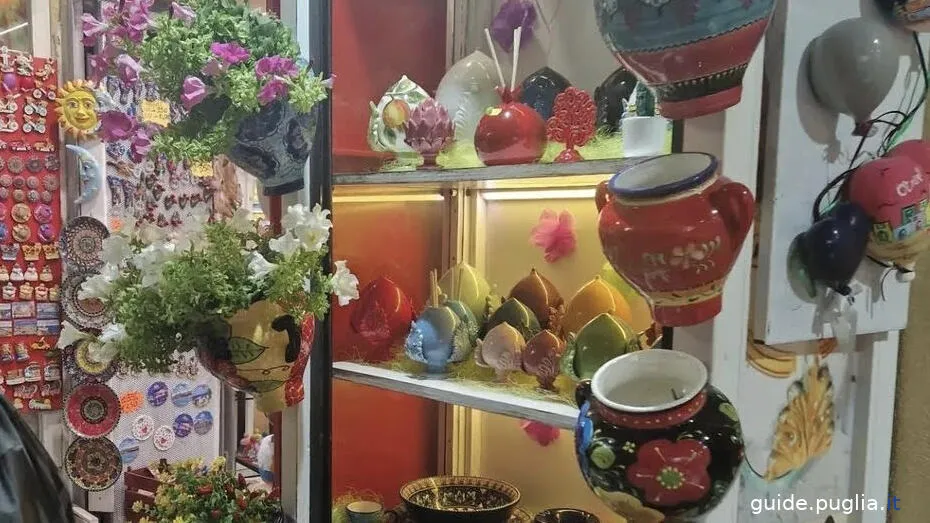
Walking through the streets of Otranto is an emotion that is rarely forgotten. The alleys, the old houses and the ancient beauty of the historic center give it an unparalleled charm, capable of captivating the heart and gaze of every visitor.
Port of Otranto

For a long time the port of Otranto was the departure and arrival station for ferries to nearby Greece or Albania.
Today it offers numerous services for the mooring of boats and for maritime activities.
The history of Otranto has always been linked to the sea, to which it owes its development and its importance.
Thanks to the sea, the village has over the centuries been the scene of landings, trade and commerce based mainly on fishing and trade by sea, before tourism occupied a primary position in the economy of the city of Otranto.
Otranto Beaches
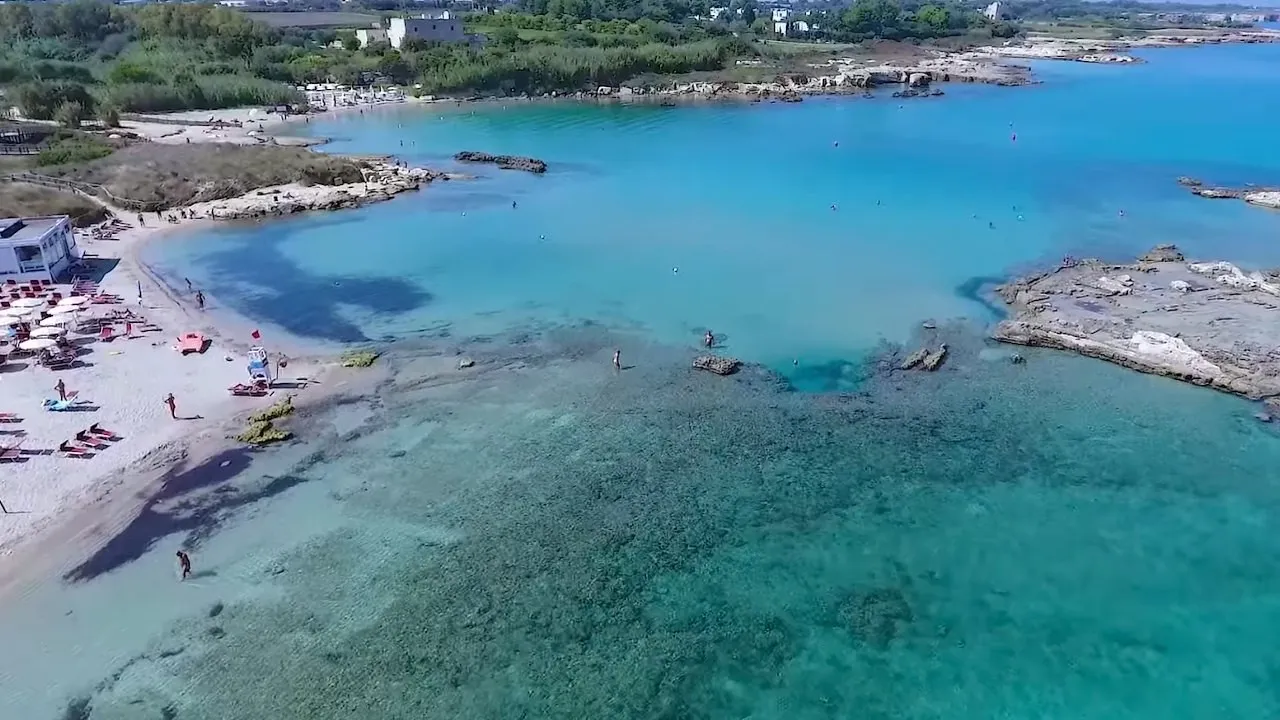
Otranto is a must-visit destination for those who love the sea, nature, and history. The city in Salento is famous for its wonderful coastline, extending about 25 km, which alternates between sandy stretches and rocky cliffs with crystal-clear water.
The coastal area of Otranto is characterized by the typical Mediterranean scrub that embraces the beaches and the rocky cliffs overlooking the sea.
Here is a list of the most beautiful beaches in Otranto:
- Baia dei Turchi
- Spiaggia degli Alimini
- Torre Sant'Andrea
- Porto Badisco
- Baia delle Orte
- Grotta della Poesia
- Baia del Mulino d'Acqua
Baia dei Turchi

Baia dei Turchi is one of the most fascinating places in Otranto. Located about 15 minutes by car from the city, it is part of the Protected Oasis of the Alimini Lakes. This bay is characterized by fine white sand, surrounded by a dense pine forest that provides pleasant shade. Tradition has it that Turkish warriors landed here during the siege of the city in the 15th century.
Here, the Mediterranean scrub surrounds the beach enclosed between two spectacular rocky ridges. On the long beach of Baia dei Turchi, you will find stretches of free beaches alternating with lidos equipped with the necessary services to spend a pleasant day at the beach. It is an ideal place to relax and enjoy the crystal-clear waters of the sea.
Spiaggia degli Alimini
Spiaggia degli Alimini is another fantastic destination, located north of Otranto. This long golden sandy beach is perfect for families due to its shallow and clear waters. Besides relaxing, you can enjoy activities like canoeing and windsurfing here. Don't miss the chance to explore the two Alimini Lakes, which offer a unique natural experience .
Torre Sant'Andrea
The Faraglioni of Sant'Andrea are one of Salento's natural wonders. This place is less crowded by mass tourism but offers spectacular scenery with its towering sea stacks and transparent waters. It is perfect for snorkeling and diving. Remember to bring rock shoes to explore safely .
Porto Badisco
Porto Badisco is a picturesque fishing village south of Otranto. This small sandy beach is ideal for those seeking tranquility and privacy.
It is perfect for snorkeling due to its crystal-clear waters. After a day at the beach, you can enjoy local cuisine in the seaside restaurants, enriching the experience .
Baia delle Orte
Hidden among cliffs and Mediterranean scrub forests, Baia delle Orte is a real treasure for adventure lovers. Accessible only by sea or through trails, this wild bay offers an intimate atmosphere and crystal-clear waters. It is the perfect refuge to escape the chaos of everyday life and immerse yourself in nature .
Grotta della Poesia
Not far from Otranto, the Grotta della Poesia is one of the most picturesque natural pools in the world. Its crystal-clear waters and hidden cave create a breathtaking landscape.
This place is tied to legends and stories of poets who came to sing the praises of a princess .
Otranto offers a variety of beaches that cater to all tastes, from total relaxation to adventure.
Each beach has its unique charm, making every visit an unforgettable experience.
Baia del Mulino d'Acqua

Another wonderful beach in Otranto is the Baia del Mulino d'Acqua (Watermill Bay), from where you can also enjoy a boat visit to the nearby Grotta Sfondata.
The Baia del Mulino d'Acqua is one of Otranto's maritime jewels, known for its uncontaminated natural beauty and its crystal clear waters. Located a few kilometers from the center of Otranto, this bay offers a unique experience away from the tourist crowds.
The bay takes its name from an ancient watermill that once stood here, although no trace of it remains today. This place was used to exploit hydraulic energy and, over time, the name remained linked to the bay.
Coastal Towers of Otranto
Traveling along the Salento coasts in the territory of Otranto you will notice numerous Coastal Towers, which stand between the various beaches, built in the 16th century by Charles V to defend the territory from invasions by the Saracens.
The coastal towers present on the coast of Otranto are:
- Fiumicelli Tower
- Torre Santo Stefano
- Torre del Serpe
- Torre dell'Orte
- Sant'Emiliano Tower
Things to see near Otranto
€ 176
€ 126.5
The things we recommend to see near Otranto are:
- Hypogeum of Torre Pinta
- Grotta dei Cervi
- Bauxite Cave and Green Lake
Hypogeum of Torre Pinta
The Ipogeo di Torre Pinta is one of Otranto's hidden archaeological gems, located in the picturesque Valle delle Memorie. Discovered in 1976, this hypogeum represents an important historical testimony, likely dating back to the Neolithic period, though the exact dating remains uncertain.
The hypogeum was built as an underground structure and may have been used as a funerary monument, temple, or early Christian catacomb. Excavations have revealed that the hypogeum has a Latin cross layout with a 33-meter-long corridor. During the Summer Solstice, the sun perfectly aligns with the main entrance, adding a mystical aura to this already fascinating place.
Access to the archaeological site of the Hypogeum of Torre Pinta is free but as it is private property it is necessary to ask permission from the owners on site for the visit.
At the Hypogeum of Torre Pinta in Otranto you can see:
- Messapian Components
- Dovecote Tower
- Valley of Memories
- Surroundings of the Hypogeum
Messapian Components
Inside the hypogeum, you can admire elements related to the Messapian culture, such as a cremation oven, cavities for cinerary urns, and a stone seat where the Messapi would place the deceased in a seated position.
Dovecote Tower
Built in the 17th century, the pigeon tower above the hypogeum served as a lookout point and a refuge for carrier pigeons. This cylindrical structure adds a picturesque and historical touch to the site.
Valley of Memories
Beyond the hypogeum, the Valle delle Memorie is a charming area to explore, rich in ancient olive trees, paths, and ancient rock structures. The valley itself offers an almost mystical atmosphere, perfect for a relaxing and contemplative walk.
Surroundings of the Hypogeum
After visiting the hypogeum, take some time to explore other attractions in the Valle delle Memorie, such as the Monastery of San Nicola di Casole and the numerous caves and rock structures.
Grotta dei Cervi
The Grotta dei Cervi, located in Porto Badisco, is among the most fascinating archaeological sites in Salento. Discovered in 1970, this cave is often referred to as the "Sistine Chapel of Prehistory" due to the richness and importance of its rock paintings, dating back to the Neolithic period (approximately 8,000-5,000 years ago)
The cave was discovered almost by chance by a group of speleologists from Maglie who, following an air current, found the entrance. Inside, around 3,000 pictograms made with red ochre and bat guano were found. These pictograms depict hunting scenes, human figures, animals, and magical symbols, offering a precious glimpse into the daily life and beliefs of Neolithic populations.
Visiting the Grotta dei Cervi is a journey back in time that offers a fascinating immersion into the prehistory of Salento, making your visit to Otranto an unforgettable experience. To preserve the paintings, access to the cave is limited and controlled. It is only possible to visit the cave with authorized guides, so it is advisable to book in advance.
Porto Badisco, where the cave is located, is a charming place with rocky coasts, turquoise sea, and the typical Mediterranean scrub of Salento. It is a great opportunity to also enjoy the surrounding natural landscape.
Things to see at the Grotta dei Cervi in Otranto in Otranto are:
- Neolithic pictograms
- Handprints
- Symbols and Spirals
Neolithic pictograms
The rock paintings are the core attraction. Among the most famous are hunting scenes of deer, which gave the cave its name. Other representations include figures of women and children, utensils, and magical-religious symbols. The "Dancing God" is one of the most iconic pictograms, probably depicting a dancing shaman.
Handprints
One of the most evocative areas of the cave is where numerous handprints are imprinted on the rock, probably left by children. These handprints seem to want to touch the observer, creating a tangible connection with the past.
Symbols and Spirals
Many of the symbols present in the cave, such as spirals, are associated with meanings of rebirth and life. These symbols reflect the religious and ritual beliefs of Neolithic populations, with a strong connection to Mother Earth.
Bauxite quarry and Green Lake
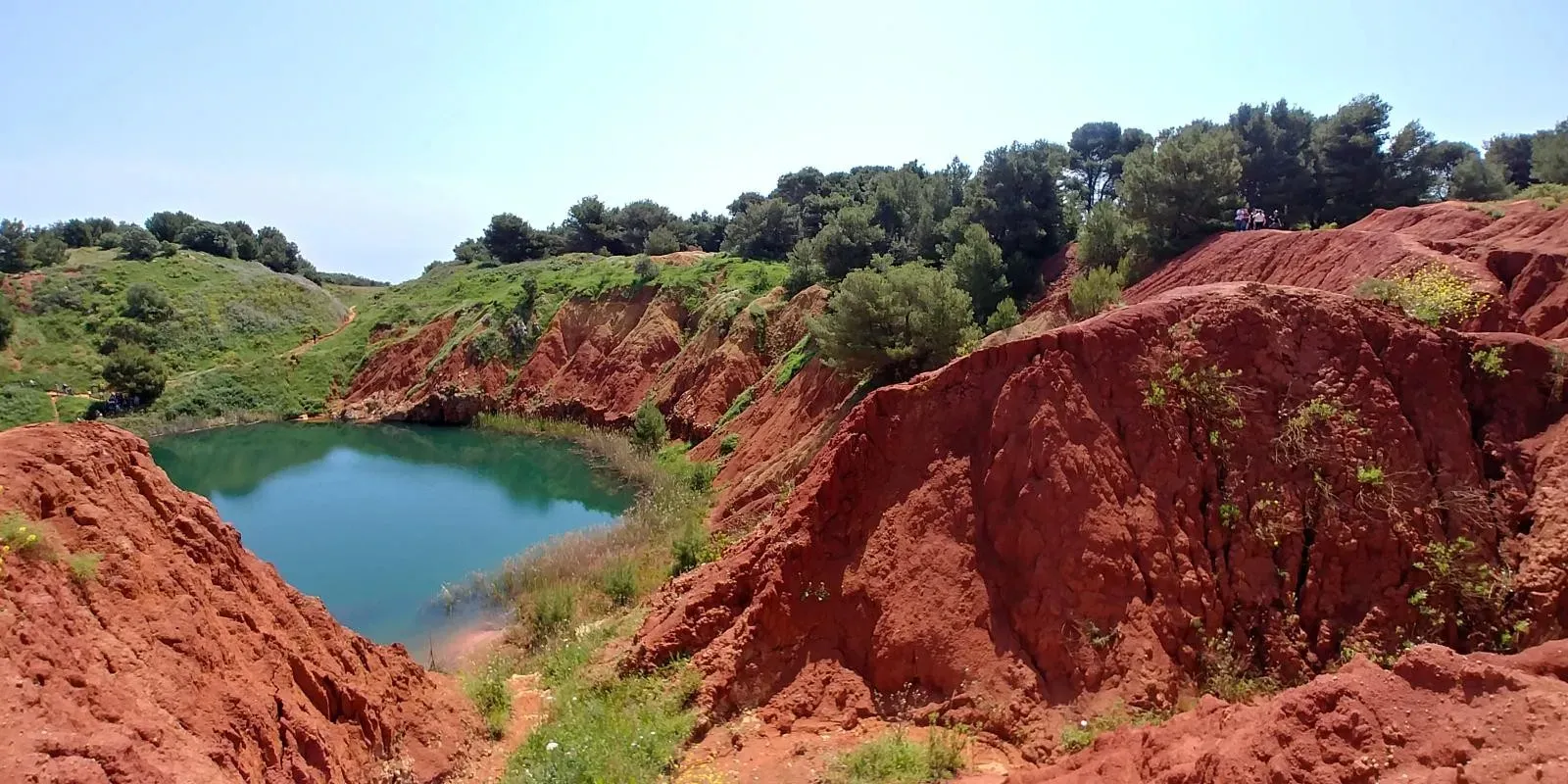
A little south of Otranto, near the Baia delle Orte, is the naturalistic area of the former bauxite quarry.
The area has been subject to naturalistic restrictions since the 70s following the disposal of the quarry and the will of the citizens to allow nature to take over.
The quarry is famous for the emerald green lake, born in the center of the quarry due to infiltration from an underlying water table.
The arid and almost alien territory inside the walls of the quarry is completely transformed immediately around the emerald green lake, which strongly contrasts with the red of the rocky walls of the quarry, making it a unique place immersed in the Mediterranean scrub just a few steps from the sea.
Masserie in Otranto
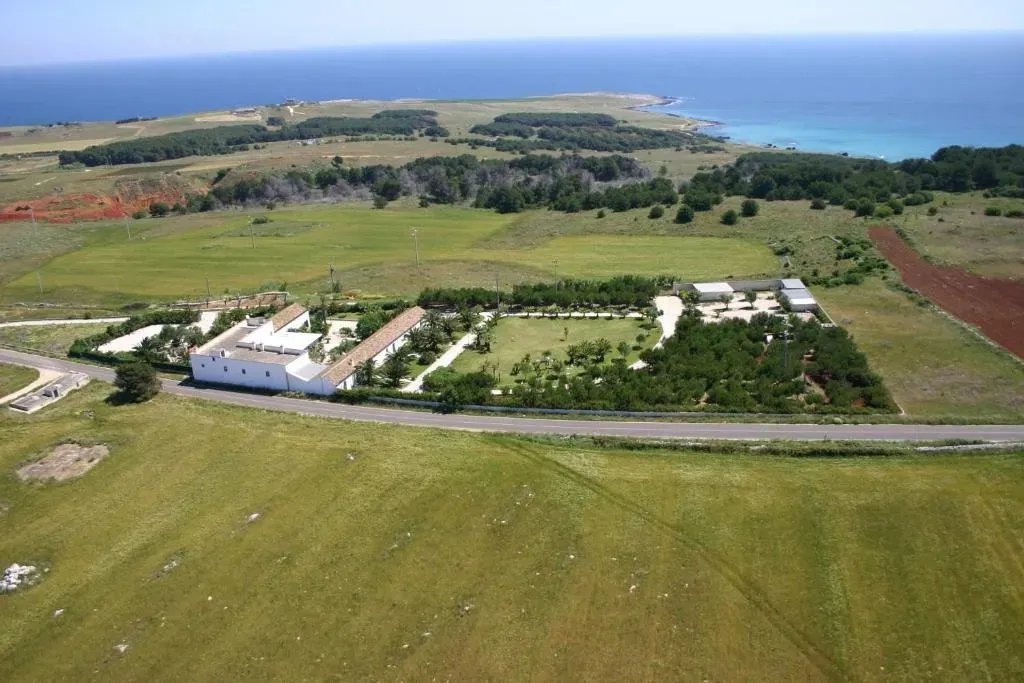
If you are in Otranto and you want to spend time in one of the most authentic places of the Salento tradition then we recommend that you visit the Masserie located in the countryside of the city.
The farms are structures built in ancient times to protect the landowners, with his entourage of servants and guards, and workers.
Today they have been restored to their former glory after being converted into wellness centers, rented farms, lodgings, farmhouses, restaurants or b & bs.
Some of the farms naturally offer hospitality to travelers in the form of accommodation but also a restaurant, bar or farmhouse and therefore it is possible to taste all the traditional goodness of the typical Apulian cuisine.
To better enjoy your holiday in Puglia it is advisable to find accommodation or rent one of the many Masserie in Otranto.
Some of the farms are directly near the sea, a few tens of meters, others are located up to a few kilometers inland but all are more than adequate to accommodate visitors looking for beauty, quiet and relaxation in the Salento style.
from € 530
When to Visit Otranto
Summer is perfect for those who love the heat and lively beaches. Spring and autumn offer mild weather and fewer crowds, ideal for exploring the city at a leisurely pace. Winter also has its charm, with a quieter and more authentic city
Otranto is a destination that combines history, nature, and culture, making it perfect for a holiday full of unforgettable experiences.
What to do in Otranto
Do you know what to do in Otranto to make your holiday unforgettable? Beyond cultural visits, this destination combines sea, nature and traditions, offering activities for every taste.
Here are some suggestions for experiences to try:
- Relaxation and the sea
- Sports and nature
- Boat tours
- Cultural and local experiences
Relaxation and the sea
Of course, spending your days on the fabulous beaches is a must. You can alternate sandy beaches (for example Alimini and Baia dei Turchi) with swims in quieter rocky coves (Baia dell’Orte, coves toward Porto Badisco). Don’t forget mask and snorkel: the sea in Otranto, so clear, is ideal for snorkeling to discover seabeds rich in fish. For the more adventurous, there are diving schools that organize scuba tours in areas full of underwater caves and wrecks.
Sports and nature
If you love staying active, Otranto won’t disappoint. You can go on scenic treks along the coastal trails of the Otranto–Leuca Natural Park, for example from the Palascìa Lighthouse to Torre Sant’Emiliano, among myrtle bushes and sea views.
Or explore the inland routes by bicycle, perhaps reaching the nearby villages of the Salento interior. Between spring and autumn the climate is perfect for walking or cycling without suffering excessive heat. Birdwatching is also possible around the Alimini Lakes, where herons and other species nest.
Boat tours
Seeing the Otranto coast from the sea is an unmissable experience. Every day in summer excursions depart from the port along the coast: north to the Sant’Andrea sea stacks and the Torre dell’Orso caves, or south to Santa Cesarea and Castro. Many tours include stops for swimming in bays accessible only by sea (such as the aforementioned Grotta Sfondata at Mulino d’Acqua).
At sunset there are also boat trips with aperitif to enjoy the sunset over the Adriatic. If you prefer autonomy, you can rent a dinghy or boat directly in Otranto (even without a boating license for small vessels) and create your own itinerary along the coast.
Cultural and local experiences
To get in tune with the Salento spirit, you can take part in some local events or traditions. In summer Otranto hosts music festivals, jazz series and pizzica dance evenings (the typical Salento dance) in the squares.
At the end of August, nearby, there is the famous “La Notte della Taranta” concert (in Melpignano, though many stay in Otranto for the occasion). On August 14th Otranto celebrates its Holy Martyrs with a heartfelt religious procession. Another evocative experience is the Dawn of the Peoples: Otranto’s New Year’s Eve with shows on the night of December 31st and a gathering before sunrise on January 1st at Punta Palascìa to greet the first sun of the year.
For shopping lovers, in the historic center you’ll find artisan workshops: you can buy a pumo in ceramic (Apulian good-luck charm), Lecce stone items, embroidered textiles and typical handmade leather sandals.
Finally, why not head to the countryside for a food and wine tasting? Nearby there are farmhouses and agricultural estates that organize tastings of extra-virgin olive oil (the gold of Salento) or wine tours to sample local wines like Negroamaro and Primitivo, often paired with typical products (cheeses, friselle, etc.).
Living these experiences will make you feel like a guest and not just a tourist, leaving you with authentic memories of Otranto and its people.
Practical Tips for Visiting Otranto
Here are some tips we’d like to share for your visit to Otranto:
- Best time to visit
- Length of stay
- Getting around the city
- Sun and heat
- Bookings
- Safety and respect
Best time to visit
The Salento climate is pleasant from April to October, but the best time for the sea is from May to September, when long, sunny days invite you to the beaches and outdoor life. July and especially August are peak season: the city is teeming with tourists, accommodations cost more, and the beaches are crowded.
If you can, choose June or September to enjoy Otranto with summer weather but more tranquility. In these “shoulder” months the sea is already (or still) warm and clear, perfect for swimming and water sports, and you can explore the historic center without the crowds.
Spring and late autumn are also excellent times for trekking and nature excursions, thanks to mild temperatures. Winter is very quiet: many facilities may reduce hours or close, but the city takes on an authentic, intimate charm, ideal for those seeking relaxation away from the crowds.
Length of stay
You can see the main attractions in Otranto in 1–2 days. However, if you also want to enjoy the sea and take excursions in the surroundings, plan for 4–5 days. In a week you can also explore other towns of eastern Salento (such as Specchia, Galatina, Lecce) while based in Otranto.
Getting around the city
The historic center of Otranto is a pedestrian zone/ZTL – you get around on foot only, and it’s small enough that you don’t need vehicles. Wear comfortable shoes because the streets are paved with natural stone. For travel outside the city, a car is the most convenient means (especially to reach isolated coves or take a tour along the coast road). In high season it can be difficult to park near the most famous beaches during peak hours: arm yourself with patience or arrive early in the morning. You might also consider renting bicycles or scooters on site, great solutions to move around nimbly while avoiding traffic and parking problems.
Sun and heat
In summer the Salento sun is strong, so high-protection sunscreen, a hat, and sunglasses are a must. Avoid staying on the beach during the central hours (12–4 PM) without adequate protection and hydration. You might take the opportunity for a light lunch in the shade or a siesta. Remember that free beaches often lack natural shade – consider bringing your own umbrella.
Bookings
If you visit Otranto in July–August, it’s wise to book well in advance both your accommodation (even months ahead, as the best hotels and B&Bs fill up quickly) and, if you’ll want them, sunbeds and umbrellas at the more renowned beach clubs. Even the most popular restaurants can be crowded in the evening: it’s better to call in the afternoon to reserve a table, especially on weekends.
Safety and respect
Otranto is a safe and welcoming city. Enjoy it with respect: in places of worship, wear appropriate and modest clothing, and don’t leave litter on the beaches (help preserve these beautiful spots). The local kindness will win you over – a smile and a greeting always please the residents and will make you feel even more welcome.
Where to stay in Otranto
There is no shortage of places to stay in Otranto, suitable for every need. The city, being a highly sought-after tourist destination, offers everything from luxury accommodations to simpler, more traditional lodgings, all set within the Salento landscape.
The types of accommodations where you can stay in Otranto are:
- Hotels and B&Bs in the historic center
- Resorts and masserie in the surrounding area
- Apartments and holiday homes
- Holiday villages and campsites
Hotels and B&Bs in the historic center
If you want to stay in the heart of the city, you’ll find boutique hotels carved out of ancient palaces just steps from the monuments. An excellent example is Palazzo Papaleo, an elegant, charming hotel full of history right next to the Cathedral. Staying downtown means you can head out on foot in the evening for a stroll along the bastion or an ice cream by the harbor, with everything within easy reach. The B&Bs and guesthouses within the walls are often small and family-run, with panoramic terraces overlooking the sea or the castle—an especially romantic option for couples. Keep in mind that parking in the center is limited: many properties have arrangements with external lots or provide shuttles for guests.
Resorts and masserie in the surrounding area
For those seeking the ultimate in relaxation, the countryside around Otranto is home to beautiful masserie (historic fortified farmhouses) converted into luxury hotels and resorts. For example, Masseria Muzza, a five-star property nestled among olive groves outside Otranto, offers an exclusive experience with a spa and pool—ideal for anyone wanting peace and comfort away from the bustle. Staying in a masseria means waking up surrounded by nature, enjoying a breakfast of local products, and perhaps dining under the stars on zero-kilometer cuisine. Many masserie also function as agritourisms, where you can savor authentic Salento cuisine on site. Although these properties lie inland (usually 2–5 km from the center or the sea), they often provide bicycles or shuttles to reach the town or nearby beaches. They are perfect for families and travelers seeking space, tranquility, and a connection with local traditions.
Apartments and holiday homes
Another popular option in Otranto is renting an apartment or holiday home, especially if you’re traveling with a group or family and want more independence. In the newer part of town, just outside the walls, there are modern residences and fully equipped houses, often with parking. This solution lets you save money by cooking at home with products you might buy at the market (try the weekly market for local fruit, vegetables, and cheeses!) and live like a local in Otranto.
Holiday villages and campsites
In the surrounding areas (Alimini and Frassanito), you’ll also find club-style holiday villages and seaside campsites, perfect for families with children or young travelers seeking an active vacation. The Camping Baia dei Turchi and the Campeggio Mulino d’Acqua offer pitches, bungalows, and entertainment in natural settings shaded by pine forests. If you love an open-air, laid-back lifestyle, these accommodations let you enjoy the sea from morning till night. Be sure to check the actual distance from Otranto’s center, especially if you don’t have a car (shuttle buses to and from town are often arranged during high season).
from € 530
from € 530
How to get to Otranto
Reaching Otranto is easy, thanks to several transportation options. You can reach Otranto, the "gateway to the East", by traveling:
- by car
- by train
- by plane
- by bus
By car
If you arrive by car, take exit Bari from the A14 motorway (if you’re coming from the north) and continue on the expressway to Lecce. From Lecce you can choose two routes: the fastest is the SS16 toward Maglie and then the exit for Otranto; the more scenic is the Adriatic coastal road via San Cataldo, which runs along the coast offering splendid sea views.
At the entrance to Otranto you’ll find parking lots and rest areas: keep in mind that the historic center is a limited traffic zone, so park outside the walls and continue on foot.
By train
The Otranto railway station is the last one in Salento, so there are no long-distance trains that go directly there. You need to take a train to Lecce (well connected to Italy’s main cities) and then use the regional Ferrovie del Sud Est trains to Otranto. The journey from Lecce takes about one hour, passing through characteristic rural landscapes.
From Otranto station you can reach the center with a short 10-minute walk or by local bus.
By plane
The nearest airport is Brindisi Casale airport, about 90 km away. From the airport you can rent a car and drive to Otranto (around 1½ hours) or take a shuttle to Lecce and then the train/bus to Otranto.
Alternatively, there is Bari Palese airport (about 200 km away); from Bari it’s best to take the train to Lecce or use a private transfer. In the high season, some shuttle services connect the airports directly to Salento.
By bus
Otranto has bus connections to the main towns in Apulia. In summer the Salento in Bus service operates, a network of coaches linking Lecce and the Salento seaside resorts, including Otranto. There are also regional bus lines throughout the year (for example from Lecce or Maglie).
The bus is an economical option (a few euros per ticket), but bear in mind that it can be slower than a car due to intermediate stops.
Travel Tips for Otranto
- Plan Ahead: Especially during the high season (summer months), it is advisable to book transportation and accommodations in advance.
- Rent a Car: To explore the wonders of Salento with more freedom, renting a car can be a winning choice.
- Check Schedules: Verify train and bus schedules online, especially if you are traveling off-season.
Getting to Otranto is simple and allows you to start your adventure in one of the most fascinating cities in Puglia.
